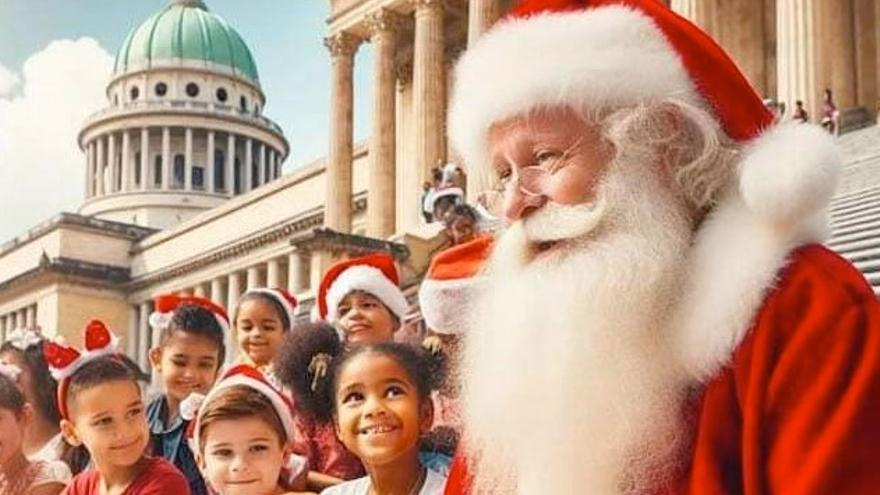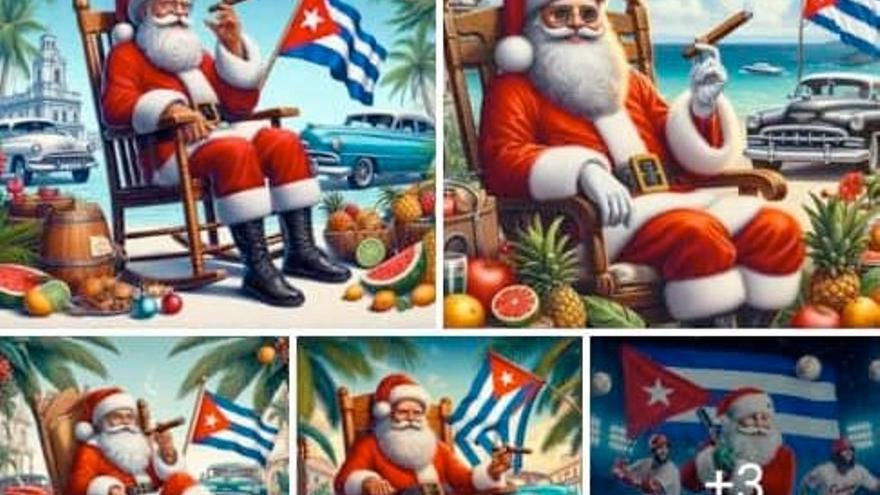
![]() 14ymedio, Havana, December 30, 2023 — With a cigar in his mouth, playing baseball and distributing gifts to the children in front of the Havana Capitolio, a chubby Santa Claus promotes Cuba as a destination for Havanatur this December. The images, created with Artificial Intelligence, have unleashed a swell of criticism from the most extremist sectors, which accuse the tourist agency of succumbing “to colonizing seduction.”
14ymedio, Havana, December 30, 2023 — With a cigar in his mouth, playing baseball and distributing gifts to the children in front of the Havana Capitolio, a chubby Santa Claus promotes Cuba as a destination for Havanatur this December. The images, created with Artificial Intelligence, have unleashed a swell of criticism from the most extremist sectors, which accuse the tourist agency of succumbing “to colonizing seduction.”
The Cuban diplomat José Carlos Rodríguez Ruiz was one of those who reacted angrily to the campaign that the State company disseminated on its Facebook account, which it took down shortly after due to criticism. The former ambassador of the Island to Italy classified Santa Claus as part of the “colonizing icons and something alien to Cuban culture.”
Rodríguez’s text, which was also published by the official newspaper Tribuna de La Habana, said that “in the face of those who easily succumb to colonizing seduction, there is only one way, which is the same as our history to keep us independent and sovereign: to be alert and confront them.” The diplomat questions whether “they will have taken away the irresponsible people who thought it up, created it and published it. We don’t know. Havanatur didn’t even issue a note apologizing. They should have.”

Rodríguez’s criticisms have been joined by those of fellow diplomat Orestes Hernández Hernández, who called to use, instead of the figure of the old man with a white beard dressed in red, characters from Cuban literature such as the puppet Pelusín del Monte, created by the writer Dora Alonso in 1956. For her part, the official journalist Ana Teresa Badia classified the tourism agency’s campaign as a “violation of all communication logic.”
A few hours after the first questions were published, the advertising disappeared from the Havanatur page; however, several users copied and disseminated the images in which Santa Claus swings in an armchair, smokes a cigar surrounded by tropical fruit, sunbathes on the shore of a beach and, in almost all the illustrations, is accompanied by an old American car.
Several commentators joined the angry reaction and classified Santa Claus as an “imperial construction” and “part of the war of symbols of the United States against Cuba.” However, the figure of the sympathetic old man has its origin in the second century A.D. when Nicholas of Bari was born into the bosom of a wealthy family in the Turkish city of Patara. When his parents died, he decided to distribute his wealth among the most needy and sought refuge from his pain in religion.
San Nicolás has a relationship with Havana that most Cubans ignore: he is the Greek Orthodox patron saint of the city
San Nicolás, in addition, has a relationship with Havana that most Cubans ignore: the Greek Orthodox community of the city adopted him as patron, because he is considered the protector of sailors and port cities. In fact, the Greek Orthodox cathedral of Old Havana is consecrated to him.
It is not the first time that this type of reaction has arisen to the use of foreign symbols or traditions. At the end of last October, the Maxim Rock Cultural Center, in Havana, organized a Halloween party in which an officer costume of the Nazi Schutzstaffel (better known by the acronym SS) worn by a contestant was awarded. The audacity cost the premises a temporary closure and sanctions to its managers, as later reported on social networks by the Cuban Institute of Music.
The entity then stated that the decision had been taken “given the seriousness of the fact and the evidence of the inability of the cultural institution to foresee it.” The note went beyond the specifics and took advantage of the controversy to put the festivity under the magnifying glass again. “The event (…) in addition to constituting a violation of the directives for cultural programming, puts the issue of the dangers of cultural colonization back on the table.”
Both the Cuban Institute of Music and the official spokespersons who criticized the event conveniently ignored that Halloween or Samhain, celebrated on the eve of All Saints’ Day, is a pagan festival of Celtic tradition that marked the end of the harvest season and the beginning of the new year. Irish emigrants imported it to the United States, where it was incorporated into popular culture with its own iconography. From there it has been re-exported all over the world, especially through the film industry.
That origin and the thousands of Cubans who disguise themselves every year to enjoy this holiday are systematically ignored by the Cuban authorities, who insist on identifying it exclusively with “the empire” and point to it as something foreign to the national culture, although the links of the Island with Celtic Galicia have been close for centuries.
Translated by Regina Anavy
____________
COLLABORATE WITH OUR WORK: The 14ymedio team is committed to practicing serious journalism that reflects Cuba’s reality in all its depth. Thank you for joining us on this long journey. We invite you to continue supporting us by becoming a member of 14ymedio now. Together we can continue transforming journalism in Cuba.
